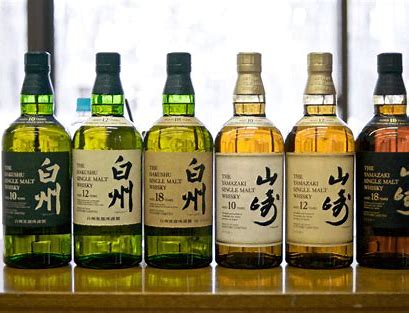Hakushu vs Yamazaki: Which One Is Better?
If you like whisky or want to learn about Japanese whisky, you might have heard of two famous brands:Hakushu and Yamazaki. Both are made in Japan, and both are loved by whisky fans all over the world. But you might be wondering,Hakushu vs Yamazaki: which one is better?
In this blog, we will explore the differences and similarities between Hakushu and Yamazaki whiskies. We will explain their history, taste, production, and what makes each special. By the end, you will have a better idea of which whisky might be best for you.
What Is Hakushu Whisky?
Hakushu is a Japanese whisky made by the Suntory company. It is named after the Hakushu distillery, which is in the Japanese Alps. This distillery is known for its fresh air, clean water, and natural beauty.
Hakushu whiskies are often called “forest whiskies” because they have a fresh, green, and herbal flavor. They taste a bit like pine trees, mint, and fresh grass. This makes them very different from other Japanese whiskies.
What Is Yamazaki Whisky?
Yamazaki is also made by Suntory, but at the Yamazaki distillery. This is Japan’s oldest whisky distillery, founded in 1923 near Kyoto. Yamazaki whiskies are known for their rich, smooth, and fruity flavors.
People say Yamazaki tastes like honey, dried fruit, and a little spice. It is softer and sweeter than Hakushu. Yamazaki is famous worldwide and has won many awards.
Hakushu vs Yamazaki: History and Location
Both whiskies come from Suntory but are made in very different places.
- Hakushu distillery is in the mountains, surrounded by forests and clean streams. This gives the whisky a fresh and natural character.
- Yamazaki distillery is in a valley near the city, where the weather is warm and humid. This makes Yamazaki whisky age well and get rich flavors.
Because of the different locations, the water and air affect the taste of each whisky.
Hakushu vs Yamazaki: Flavor Profiles
One of the biggest differences between Hakushu and Yamazaki is how they taste.
Hakushu Flavor
- Fresh and herbal
- Pine and mint notes
- Slightly smoky
- Crisp and light
Hakushu is great for people who like whiskies that taste clean and refreshing.
Yamazaki Flavor
- Rich and fruity
- Honey and dried fruit
- Spicy and smooth
- Full-bodied
Yamazaki is perfect for those who want a soft, sweet, and complex whisky.
Hakushu vs Yamazaki: Types and Age Statements
Both Hakushu and Yamazaki come in different versions with different ages.
- Hakushu 12 Year Old is popular and shows the fresh, herbal style.
- Hakushu Distiller’s Reserve is a younger whisky with lively fruit and smoke.
- Yamazaki 12 Year Old is the most famous Yamazaki, smooth and fruity.
- Yamazaki 18 Year Old is rich and deep, for serious whisky lovers.
Each age tells you how long the whisky stayed in barrels before bottling. Older whiskies usually taste smoother and more complex.
Hakushu vs Yamazaki: Production Methods
Both whiskies use traditional methods, but they have some differences.
- Hakushu uses a lot of peat smoke in some expressions, which adds a smoky flavor.
- Yamazaki mostly uses unpeated malt, so it is less smoky and more fruity.
- Both use different types of barrels like American oak, European oak, and Mizunara oak (a special Japanese oak).
These choices affect the flavor and aroma of the final whisky.
Hakushu vs Yamazaki: Which One Is Better?
The answer depends on your personal taste.
- If you like fresh, green, and smoky whisky, Hakushu might be better for you.
- If you prefer sweet, fruity, and smooth whisky, Yamazaki could be the one.
- Some people love both and enjoy comparing them side by side.
Try both whiskies if you can, and see which flavors you like best.
How to Enjoy Hakushu and Yamazaki Whiskies
Here are some tips to enjoy these whiskies:
- Drink them neat or with a little water to open the flavors.
- Use a tulip-shaped glass to catch the aromas.
- Pair them with light foods like sushi, grilled fish, or cheese.
- Try tasting Hakushu and Yamazaki side by side for fun.
Related Key Phrases Used Naturally
In this post, we also used phrases like:
- Japanese whisky Hakushu vs Yamazaki
- Hakushu 12 year old review
- Yamazaki 12 year old tasting notes
- Differences between Hakushu and Yamazaki
- Best Japanese whisky for beginners
These help search engines understand the topic and help you find more related articles.
Internal Links You Might Like
- Check out our full Japanese Whisky Collection for more brands and types.
- Learn how to read whisky labels with our DIY Macallan Label Reading Guide.
- Discover the rare Mizunara Oak Whiskies and why they matter.
Call to Action: Buy Hakushu or Yamazaki Today
Ready to try these amazing Japanese whiskies? Visit the shop at WhiskeyWorlds.com to browse our collection of Hakushu and Yamazaki bottles.
Whether you want the fresh herbal flavors of Hakushu or the rich fruity taste of Yamazaki, we have the perfect bottle for you. Shop today and enjoy the best of Japanese whisky!
Final Thoughts
The question Hakushu vs Yamazaki: Which One Is Better? does not have a simple answer. Both are fantastic whiskies made with care and skill.
Hakushu offers a fresh, green, and sometimes smoky experience. Yamazaki gives rich, sweet, and fruity notes. Which one you like better depends on your taste.
Try both, explore more Japanese whiskies, and enjoy your whisky journey!

